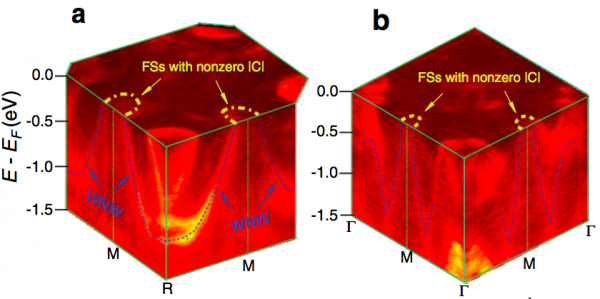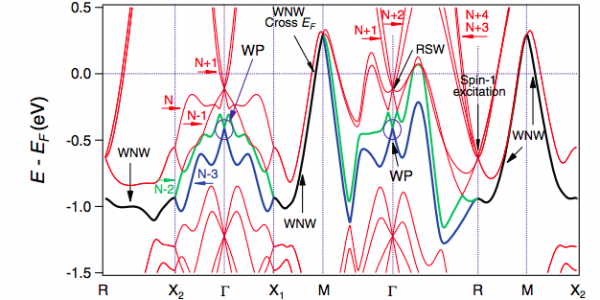Unpaired Weyl point observed for first time in Weyl semimetal platinum gallium PtGa
by Carey Sargent, NCCR MARVEL, EPFL
Weyl fermions in any crystal are generally considered to be subject to the so-called Nielsen–Ninomiya no-go theorem, which requires Weyl points to appear in pairs with opposite chirality. These pairs manifest in the appearance of surface Fermi arcs connecting the projections of the WPs on the surface of the Brillouin zone and for this reason, the existence of paired WPs in the bulk and Fermi arcs on the surfaces have been essential characteristics for seeking and identifying all WSMs to date, with no exception.
Since the physics of Weyl semi-metals has only developed in the past decade, well after the derivation of the no-go theorem, Nielsen-Ninomiya doesn’t give a precise description or derivation for application on nodal surfaces. Researchers have recently suggested that the theorem can be circumvented when the WP is surrounded by topological nontrivial Weyl nodal walls (WNWs), allowing for the appearance of a singular WP without an opposite chiral point charge counterpart.
Though much theoretical effort has been dedicated to searching for unpaired WPs, none have been observed experimentally so far, nor have any electronic topological WNWs/surfaces been experimentally reported in crystalline solids up to date.

Fermi surfaces with nonzero Chern number near M points.
In the paper “Observation of a singular Weyl point surrounded by charged nodal walls in PtGa,” recently published in Nature Communications, researchers show that such Weyl fermions—capable of changing the topological properties of WSM such as the chiral anomalous effect, anomalous spin Hall effect, etc.—can emerge in a variety of compounds.
Their work, based on a combination of angle-resolved photoemission spectroscopy and density functional theory calculations, allowed them to show experimentally that such a singular Weyl point exists in platinum gallium PtGa. Found at the center of the Brillouin zone, the Berry curvature of this unpaired WP is absorbed by the closed Weyl nodal walls that surround it at the BZ boundaries. The nodal wall can be considered the counterpoint of the nodal point and no related topologically protected Fermi arc surface is necessary, nor was it observed.
The results show that nontrivial band crossings of different dimensionalities can exist at the same time in condensed matter and that their coexistence ensures that the net topological charge of the objects is zero. The observations extend the applicable range of the original Nielsen-Ninomiya no-go theorem, derived from zero dimensional paired WPs with opposite chirality, to include pairs of topological objects with different dimensions.

Bulk band structure of PtGa along high symmetry lines.
Additional theoretical considerations and band structure calculations allowed the researchers to further predict that such novel WPs can also be realized in all members of the cobalt silicide family, including CoSi, AlPt, RhSi, FeSi, ReSi and other materials. They note that ReSi is a particularly interesting compound because a single unpaired WP almost exactly at the Fermi level makes it an ideal candidate for studying transport properties. Various other families of materials such as a high-pressure phase of Ge are also promising candidates for hosting singular Weyl fermions, the researchers said.
The lack of topological surface states in such materials means that the response to external fields will directly indicate their bulk Weyl fermion characteristics. Moreover, magneto-transport phenomena such as chiral anomaly and the anomalous Hall effect, which are related to the geometry of the locations of the paired WPs, are thought to be the fingerprints of Weyl semimetals. The geometry between unpaired WPs and WNWs is quite different from that of normal WSMs though so transport properties are expected to change significantly, and further research will be needed.
Overall, the confirmation of Weyl fermion pairs between 0D points and 2D nodal walls in crystalline solids will open a new avenue to the bulk topological properties of Weyl fermions in solids, the researchers said, in turn promoting the understanding of basic topological physics and application of WSMs into spintronics.


Reference:
Ma, JZ., Wu, QS., Song, M. et al., Observation of a singular Weyl point surrounded by charged nodal walls in PtGa, Nature Communications 12, 3994 (2021).
https://doi.org/10.1038/s41467-021-24289-0
Low-volume newsletters, targeted to the scientific and industrial communities.
Subscribe to our newsletter